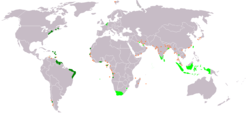Dutch colonies
|
Dutch Empire
|
|
|---|---|

Flag
|
|

An anachronous map of the Dutch colonial Empire.
Light green: territories administered by or originating from territories administered by the Dutch East India Company |
Light green: territories administered by or originating from territories administered by the Dutch East India Company
The Dutch Empire (Dutch: het koloniale rijk van Nederland) comprised the overseas territories controlled by the Dutch Republic and, later, the modern Netherlands from the 17th century to the mid-1950s. The Dutch followed Portugal and Spain in establishing an overseas colonial empire. For this, they were aided by their skills in shipping and trade and the surge of nationalism accompanying the struggle for independence from Spain. Before and later alongside the British, the Dutch initially built up colonial possessions on the basis of indirect state capitalist corporate colonialism, via the Dutch East and West India Companies. Dutch exploratory voyages such as those led by Willem Barentsz, Henry Hudson and Abel Tasman revealed vast new territories to Europeans, particularly in the Arctic Sea, North America, in the Pacific, Australia, and New Zealand.
With Dutch naval power rising rapidly as a major force from the late 16th century, the Netherlands dominated global commerce during the second half of the 17th century during a cultural flowering known as the Dutch Golden Age. The Netherlands lost many of its colonial possessions, as well as its global power status, to the British when the metropole fell to French armies during the Revolutionary Wars. The restored portions of the Dutch Empire, notably the Dutch East Indies and Suriname, remained under Dutch control until the decline of European imperialism following World War II. Since the 1950s, the Netherlands has been organized as constituent countries composing the Kingdom of the Netherlands. As of October 10, 2010, the countries within the kingdom are the Netherlands proper, Aruba, Curaçao, and Sint Maarten.
...
Wikipedia
